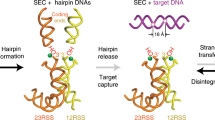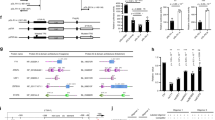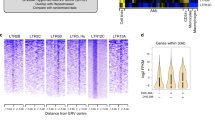Abstract
We have identified a silencer and an antisilencing element that interact at a distance of 85 kilobases to regulate expression of the recombination activating genes Rag1 and Rag2 in thymocytes. Transgenic experiments showed that Rag promoter-proximal cis elements directed tissue-specific expression and that a Runx-dependent intergenic silencer suppressed expression in developing T cells. Deletion of the antisilencing element from the genomic Rag locus unmasked the intergenic silencer and abrogated Rag expression in developing CD4+CD8+ T cells. We speculate that the Rag antisilencing element belongs to a class of cis elements that might be useful for genome diversification by activating genes encoded by otherwise silent transposable elements.
This is a preview of subscription content, access via your institution
Access options
Subscribe to this journal
Receive 12 print issues and online access
$209.00 per year
only $17.42 per issue
Buy this article
- Purchase on Springer Link
- Instant access to full article PDF
Prices may be subject to local taxes which are calculated during checkout






Similar content being viewed by others
Accession codes
References
Schatz, D.G., Oettinger, M.A. & Baltimore, D. The V(D)J recombination activating gene, RAG-1. Cell 59, 1035–1048 (1989).
Oettinger, M.A., Schatz, D.G., Gorka, C. & Baltimore, D. RAG-1 and RAG-2, adjacent genes that synergistically activate V(D)J recombination. Science 248, 1517–1523 (1990).
McBlane, J.F. et al. Cleavage at a V(D)J recombination signal requires only RAG1 and RAG2 proteins and occurs in two steps. Cell 83, 387–395 (1995).
Schluter, S.F. & Marchalonis, J.J. Cloning of shark RAG2 and characterization of the RAG1/RAG2 gene locus. FASEB J. 17, 470–472 (2003).
Mombaerts, P. et al. RAG-1-deficient mice have no mature B and T lymphocytes. Cell 68, 869–877 (1992).
Shinkai, Y. et al. RAG-2-deficient mice lack mature lymphocytes owing to inability to initiate V(D)J rearrangement. Cell 68, 855–867 (1992).
Wilson, A., Held, W. & MacDonald, H. Two waves of recombinase gene expression in developing thymocytes. J. Exp. Med. 179, 1355–1360 (1994).
Petrie, H. et al. Multiple rearrangements in T cell receptor α chain genes maximize the production of useful thymocytes. J. Exp. Med. 178, 615–622 (1993).
Shinkai, Y. et al. Restoration of T cell development in RAG-2-deficient mice by functional TCR transgenes. Science 259, 822–825 (1993).
von Boehmer, H. & Fehling, H.J. Structure and function of the pre-T cell receptor. Annu. Rev. Immunol. 15, 433–452 (1997).
Turka, L.A. et al. Thymocyte expression of RAG-1 and RAG-2: termination by T cell receptor cross-linking. Science 16, 778–781 (1991).
Borgulya, P., Kishi, H., Uematsu, Y. & von Boehmer, H. Exclusion and inclusion of α and β T cell receptor alleles. Cell 69, 529–537 (1992).
Yannoutsos, N. et al. The role of recombination activating gene (RAG) reinduction in thymocyte development in vivo . J. Exp. Med. 194, 471–480 (2001).
Guo, J. et al. Regulation of the TCRα repertoire by the survival window of CD4+CD8+ thymocytes. Nat. Immunol. 3, 469–476 (2002).
Gay, D., Saunders, T., Camper, S. & Weigert, M. Receptor editing: an approach by autoreactive B cells to escape tolerance. J. Exp. Med. 177, 999–1008 (1993).
Tiegs, S.L., Russell, D.M. & Nemazee, D. Receptor editing in self-reactive bone marrow B cells. J. Exp. Med. 177, 1009–1020 (1993).
Yu, W. et al. Continued RAG expression in late stages of B cell development and no apparent re-induction after immunization. Nature 400, 682–687 (1999).
Monroe, R.J. et al. RAG2:GFP knockin mice reveal novel aspects of RAG2 expression in primary and peripheral lymphoid tissues. Immunity 11, 201–212 (1999).
Monroe, R.J., Chen, F., Ferrini, R., Davidson, L. & Alt, F.W. RAG2 is regulated differentially in B and T cells by elements 5′ of the promoter. Proc. Natl. Acad. Sci. USA 96, 12713–12718 (1999).
Yu, W. et al. Coordinate regulation of RAG1 and RAG2 by cell type-specific DNA elements 5′ of RAG2. Science 285, 1080–1084 (1999).
Hsu, L.Y. et al. A conserved transcriptional enhancer regulates RAG gene expression in developing B cells. Immunity 19, 105–117 (2003).
Fuller, K. & Storb, U. Identification and characterization of the murine Rag1 promoter. Mol. Immunol. 34, 939–954 (1997).
Miranda, G.A. et al. Combinatorial regulation of the murine RAG-2 promoter by Sp1 and distinct lymphocyte-specific transcription factors. Mol. Immunol. 38, 1151–1159 (2002).
Li, Q., Peterson, K.R., Fang, X. & Stamatoyannopoulos, G. Locus control regions. Blood 100, 3077–3086 (2002).
Muller, H. Types of visible variations induced by X-rays in Drosophila. J. Genet. 22, 299–334 (1930).
Wakimoto, B.T. Beyond the nucleosome: epigenetic aspects of position-effect variegation in Drosophila. Cell 93, 321–324 (1998).
Grosveld, F., van Assendelft, G.B., Greaves, D.R. & Kollias, G. Position-independent, high-level expression of the human β-globin gene in transgenic mice. Cell 51, 975–985 (1987).
Bonifer, C., Yannoutsos, N., Kruger, G., Grosveld, F. & Sippel, A.E. Dissection of the locus control function located on the chicken lysozyme gene domain in transgenic mice. Nucleic Acids Res. 22, 4202–4210 (1994).
Lakso, M. et al. Efficient in vivo manipulation of mouse genomic sequences at the zygote stage. Proc. Natl. Acad. Sci. USA 93, 5860–5865 (1996).
Festenstein, R. et al. Locus control region function and heterochromatin-induced position effect variegation. Science 271, 1123–1125 (1996).
de Boer, J. et al. Transgenic mice with hematopoietic and lymphoid specific expression of Cre. Eur. J. Immunol. 33, 314–325 (2003).
Taniuchi, I., Sunshine, M.J., Festenstein, R. & Littman, D.R. Evidence for distinct CD4 silencer functions at different stages of thymocyte differentiation. Mol. Cell 10, 1083–1096 (2002).
Taniuchi, I. et al. Differential requirements for Runx proteins in CD4 repression and epigenetic silencing during T lymphocyte development. Cell 111, 621–633 (2002).
Rajewsky, N., Socci, N.D., Zapotocky, M. & Siggia, E.D. The evolution of DNA regulatory regions for proteo-γ bacteria by interspecies comparisons. Genome Res. 12, 298–308 (2002).
Zavolan, M., Rajewsky, K., Socci, N.D. & Gaasterland, T. SMASHing regulatory sites in DNA by human-mouse sequence comparisons. Proc. Comput. Systems Bioinformatics CSB2003, 277–286 (2003).
Dillon, N. & Festenstein, R. Unravelling heterochromatin: competition between positive and negative factors regulates accessibility. Trends Genet. 18, 252–258 (2002).
Milot, E. et al. Heterochromatin effects on the frequency and duration of LCR-mediated gene transcription. Cell 87, 105–114 (1996).
Kioussis, D. & Festenstein, R. Locus control regions: overcoming heterochromatin-induced gene inactivation in mammals. Curr. Opin. Genet. Dev. 7, 614–619 (1997).
Baxter, J., Merkenschlager, M. & Fisher, A.G. Nuclear organisation and gene expression. Curr. Opin. Cell Biol. 14, 372–376 (2002).
Francastel, C., Walters, M.C., Groudine, M. & Martin, D.I. A functional enhancer suppresses silencing of a transgene and prevents its localization close to centrometric heterochromatin. Cell 99, 259–269 (1999).
Lundgren, M. et al. Transcription factor dosage affects changes in higher order chromatin structure associated with activation of a heterochromatic gene. Cell 103, 733–743 (2000).
Flajnik, M.F. Comparative analyses of immunoglobulin genes: surprises and portents. Nat. Rev. Immunol. 2, 688–698 (2002).
Agrawal, A., Eastman, Q.M. & Schatz, D.G. Transposition mediated by RAG1 and RAG2 and its implications for the evolution of the immune system. Nature 394, 744–751 (1998).
Hiom, K., Melek, M. & Gellert, M. DNA transposition by the RAG1 and RAG2 proteins: a possible source of oncogenic translocations. Cell 94, 463–470 (1998).
Misulovin, Z., Yang, X.W., Yu, W., Heintz, N. & Meffre, E. A rapid method for targeted modification and screening of recombinant bacterial artificial chromosome. J. Immunol. Methods 257, 99–105 (2001).
Bunting, M., Bernstein, K.E., Greer, J.M., Capecchi, M.R. & Thomas, K.R. Targeting genes for self-excision in the germ line. Genes Dev. 13, 1524–1528 (1999).
Jareborg, N., Birney, E. & Durbin, R. Comparative analysis of noncoding regions of 77 orthologous mouse and human gene pairs. Genome Res. 9, 815–824 (1999).
Altschul, S.F., Gish, W., Miller, W., Myers, E.W. & Lipman, D.J. Basic local alignment search tool. J. Mol. Biol. 215, 403–410 (1990).
Nagaoka, H., Gonzalez-Aseguinolaza, G., Tsuji, M. & Nussenzweig, M.C. Immunization and infection change the number of recombination activating gene (RAG)-expressing B cells in the periphery by altering immature lymphocyte production. J. Exp. Med. 191, 2113–2120 (2000).
Acknowledgements
We thank K. Velinzon for flow cytometry cell sorting; members of the Nussenzweig laboratory and D. Dorsett for discussions; E. Besmer for help with the manuscript, and M. Zavolan for discussions and help with customizing SMASH; and D. Kioussis for the CD2 cassette. Supported in part by National Institutes of Health and Howard Hughes Medical Institute (M.C.N.).
Author information
Authors and Affiliations
Corresponding authors
Ethics declarations
Competing interests
The authors declare no competing financial interests.
Rights and permissions
About this article
Cite this article
Yannoutsos, N., Barreto, V., Misulovin, Z. et al. A cis element in the recombination activating gene locus regulates gene expression by counteracting a distant silencer. Nat Immunol 5, 443–450 (2004). https://doi.org/10.1038/ni1053
Received:
Accepted:
Published:
Issue Date:
DOI: https://doi.org/10.1038/ni1053
This article is cited by
-
Evidence for a role of RUNX1 as recombinase cofactor for TCRβ rearrangements and pathological deletions in ETV6-RUNX1 ALL
Scientific Reports (2020)
-
Fidelity of a BAC-EGFP transgene in reporting dynamic expression of IL-7Rα in T cells
Transgenic Research (2012)
-
Decision by committee: new light on the CD4/CD8‐lineage choice
Immunology & Cell Biology (2009)
-
Characterizing disease states from topological properties of transcriptional regulatory networks
BMC Bioinformatics (2006)
-
Pursuing gene regulation 'logic' via RNA interference and chromatin immunoprecipitation
Nature Immunology (2006)



